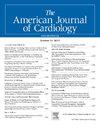静息心率和心率变异性在12导联心电图中的预后价值:来自CODE数据库的死亡率数据。
IF 2.3
3区 医学
Q2 CARDIAC & CARDIOVASCULAR SYSTEMS
引用次数: 0
摘要
静息心率(HR)和心率变异性(HRV)反映心血管自主控制,并与预后因素有关。我们的目的是评估远程心电图队列网络中HR和HRV的预后价值。我们评估了2010-2017年间巴西远程心电图数据库中记录的≥16岁患者的独特12导联心电图。感兴趣的变量是HR和正常RR区间的标准差(SDNN)。对四个Cox模型进行调整,以评估HR和HRV与相关结果(全因死亡率和心血管死亡率,由死亡证明中的ICD代码评估)之间的关系:模型1。未经调整的;2. 根据性别和年龄进行调整;3. 模型2 + 危险因素及临床合并症;4. 模型3分别对HRV或HR进行 + 调整。共纳入992.611人,中位年龄55岁。6年间,共有33.292人(3.37%)死亡,其中21%死于心血管疾病。调整后(模型4),所有的HR四分位数都与逐渐增加的全因死亡风险独立相关,第4四分位数高出88% (HR=1.88 (95%CI 1.77-1.89))。同样,在最终模型中,第1和第2 HRV四分位数仍然与全因死亡率增加相关(第1四分位数HR=1.42 (95%CI 1.37-1.47)。HR(第4四分位数:HR=1.77 95%CI 1.65-1.91)和HRV(第1四分位数:HR=1.33, 95%CI 1.23-1.44)也是心血管疾病死亡率的独立预测因子(模型4)。综上所述,在巴西成年人的大型队列中,基线HR和HRV是全因死亡率和心血管死亡率的独立预测因子,即使在相互调整后也是如此。本文章由计算机程序翻译,如有差异,请以英文原文为准。
Prognostic Value of Resting Heart Rate and Heart Rate Variability in the 12-lead Electrocardiogram: Mortality Data from the CODE Database
Resting heart rate (HR) and heart rate variability (HRV) reflect cardiovascular autonomic control and are implicated as prognostic factors. We aimed to evaluate the prognostic value of HR and HRV in a tele-ECG cohort network. We assessed unique 12-lead ECGs recorded from patients ≥16 years, from a tele-ECG database in Brazil, between 2010 and 2017. Variables of interest were HR and standard deviation of normal RR intervals (SDNN). Four Cox models were adjusted to evaluate the association between HR and HRV and the outcomes of interest (all-cause and cardiovascular mortality, assessed by ICD codes from death certificates): model (1) Unadjusted; (2) Adjusted for sex and age; (3) Model 2 + risk factors and clinical comorbidities; (4) Model 3 + adjustment for HRV or HR, respectively. At total 992,611 individuals were included, median age of 55 years. In 6 years, there were 33,292 (3.37%) deaths, 21% due to cardiovascular causes. After adjustments (model 4), all HR quartiles were independently associated with a progressively increased risk of all-cause mortality, being 88% higher for the fourth quartile (HR = 1.88, 95% CI 1.77 to 1.89). Similarly, the first and second HRV quartiles remained associated with increased all-cause mortality (first quartile [HR] = 1.42, 95% CI 1.37 to 1.47) in the final model. HR (fourth quartile: [HR] = 1.77, 95% CI 1.65 to 1.91) and HRV (first quartile: [HR] = 1.33, 95% CI 1.23 to 1.44) were also independent predictors (model 4) of cardiovascular mortality. In conclusion, in a large cohort of Brazilian adults, baseline HR and HRV were independent predictors of all-cause and cardiovascular mortality, even when adjusted for each other.
求助全文
通过发布文献求助,成功后即可免费获取论文全文。
去求助
来源期刊

American Journal of Cardiology
医学-心血管系统
CiteScore
4.00
自引率
3.60%
发文量
698
审稿时长
33 days
期刊介绍:
Published 24 times a year, The American Journal of Cardiology® is an independent journal designed for cardiovascular disease specialists and internists with a subspecialty in cardiology throughout the world. AJC is an independent, scientific, peer-reviewed journal of original articles that focus on the practical, clinical approach to the diagnosis and treatment of cardiovascular disease. AJC has one of the fastest acceptance to publication times in Cardiology. Features report on systemic hypertension, methodology, drugs, pacing, arrhythmia, preventive cardiology, congestive heart failure, valvular heart disease, congenital heart disease, and cardiomyopathy. Also included are editorials, readers'' comments, and symposia.
 求助内容:
求助内容: 应助结果提醒方式:
应助结果提醒方式:


